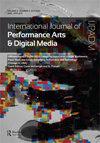‘Annotation and choreographic self-awareness’
IF 0.9
0 THEATER
International Journal of Performance Arts and Digital Media
Pub Date : 2021-01-02
DOI:10.1080/14794713.2021.1880172
引用次数: 0
Abstract
ABSTRACT Through my doctoral research I developed a form of annotation and analysis of works to explore experiences of emotion in contemporary theatre dance. This approach helped me analyse works by different choreographers and share my spectatorial experience of them. To explore whether the work had emotional information embodied in its perceptual properties, I analysed movement qualities, movement-music, and spatial-rhythm. Through these analysis I was able to understand aspects of my process which were not obvious before. The analysis seemed to improve my choreographic self- awareness. Scholars such as Sarah Whatley have pointed at the potential of documenting, sharing, and curating information about choreographic practices, and its use as feedback tool for the choreographers [Whatley, Sarah. 2018. “Enhancing Choreographic Objects; Traces, Texts and Tales of a Journey Through Dance.” In Performing Process Sharing Dance and Choreographic Practice, edited by Hetty Blades and Emma Meehan, 67–80. Bristol: Intellect]. But what happens when the analyst and the choreographer are the same person? For me, the process became a form of self-discovery. This article is a reflection on the difficulties, implications, and repercussions of undertaking a systematic analysis/annotation of my work, especially in relation to emotion.“诠释与舞蹈自我意识”
摘要通过我的博士研究,我开发了一种对作品进行注释和分析的形式,以探索当代戏剧舞蹈中的情感体验。这种方法帮助我分析不同编舞家的作品,并分享我对它们的观看经验。为了探究作品的感性特征中是否包含情感信息,我分析了动作品质、动作音乐和空间节奏。通过这些分析,我能够理解我的过程中以前不明显的方面。这个分析似乎提高了我的舞蹈自我意识。Sarah Whatley等学者指出了记录、分享和策划舞蹈实践信息的潜力,以及将其用作编舞家的反馈工具[Whatley,Sarah.2018。“增强编舞对象;舞蹈之旅的痕迹、文本和故事”,《表演过程共享舞蹈和编舞实践》,由Hetty Blades和Emma Meehan编辑,67–80岁。布里斯托尔:智力]。但是,当分析师和编舞是同一个人时会发生什么呢?对我来说,这个过程变成了一种自我发现。这篇文章反映了对我的作品进行系统分析/注释的困难、含义和影响,尤其是与情感有关的分析/注释。
本文章由计算机程序翻译,如有差异,请以英文原文为准。
求助全文
约1分钟内获得全文
求助全文
来源期刊

International Journal of Performance Arts and Digital Media
Arts and Humanities-Visual Arts and Performing Arts
CiteScore
1.70
自引率
0.00%
发文量
29
 求助内容:
求助内容: 应助结果提醒方式:
应助结果提醒方式:


